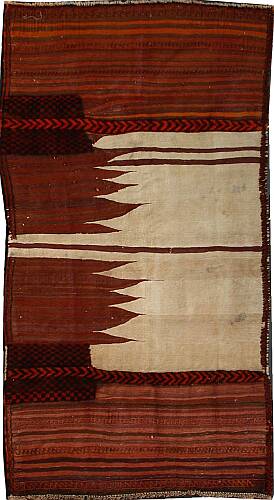Posted by Louis_Dubreuil on 01-27-2005 06:47 AM:
Puzzling Bagfaces
Recently I purchased at a reasonable cost four bag faces. They were labeled
"kashkuli" or kashgai, from Iran.

Bag 1

Bag 2

Bag3

Bag4
Obviously, Bag 3 is a
classical Bakhtiari double saddle bag. The three others also look like Bakhtiari
"tachehs".
Bags 1, 2 and 3 are obviously new. The Bakhtiari saddle bag
has cotton warps, one of the two others is all wool with what looks like camel
hair for warps, and the third has also cotton warps and the white motifs also
made of cotton (hand spun).
Bag 4 looks more old (signs of wear, stains).
It has cotton warps and the white field is also hand spun cotton weft faced. The
design of this one is very attractive and seems original. In the red ground
lateral parts some bands have brocaded zig zag motifs.
The questions are
:
- is the Kashkuli attribution a likely one or those items are really
Bakhtiar or Chahar Mahal (see Tanavoli's book) and mislabeled by the
dealer?
- in the case of a real Kashkuli making is this genuine (this fact is
not documented) or is it a copy of Bakhtiar bags for the market ?
thanks
at all turkotekers for their lights
Louis Dubreuil
Posted by Louis Dubreuil on 02-01-2005 10:00 AM:
out of ideas ?
I am astonished to have not any answer about he bags. Many viewers but no
comments. Maybe pictures are'nt enought explicit.
Is there not any "tachehs"
connoisseurs ? I'll send to steve more detailed pictures.
Meilleures
salutations à tous
Louis Dubreuil
Posted by Louis_Dubreuil on 02-02-2005 01:59 PM:
In order to increase the attraction of the bags here are some detailed
pictures of bag 2, bag 3 and bag 4.
The more I see bag 4, the more I
like it. Two hypothesis about this latter: first it is a "good" one, rescued
from the far country, second it is a "fake" with hard ageing technics. In this
case I find the weaver very skillful. But there is not "fraud" as it was sold
for "new", not "late XIX°".
Louis Dubreuil





.jpg)





Posted by Patrick Weiler on 02-02-2005 10:21 PM:
Puzzles
Louis,
For the tacheh challenged among us, how were these bags folded
for use? With a typical saddlebag, such as bag 3, the top 1/4 was folded down
and the bottom 1/4 was folded up. This made two enclosures, with enough area in
the middle for closure loops. Are there any vestigal closure loops on these
tacheh? Were they folded in the middle?
Due to the relatively recent book by
Tanavoli about tacheh, I would not expect any "fakes" to be made. These weavings
were probably made for their usual usage up until now, so there will be older
and newer versions still extant.
Patrick Weiler
Posted by Louis Dubreuil on 02-03-2005 04:48 AM:
Folding
Hi Patrick
The tacheh four is, as Tanavoli write, a double tacheh. The
red vertical line in the middle is the line separating the two pouches. For each
pouch the folding line is on the vertical axis of the piled part of the bag. The
ends are sewed folowing the red vertical axis. The two lateral borders are not
identical. The upper is reinforced by a special seam, as it is indicated in the
Tanavoli's description.
The two other bags do not have this feature : the
two lateral seams are identical. This is why, in my opinion, with the fact they
are new and due to their looser weaving, we can consider those two bags being
made just for the market and not for use.
The question remains of their
origin : Kashkuli or Chahar Mahal ?
Meilleures salutations
louis
Dubreuil
Posted by Filiberto Boncompagni on 02-03-2005 05:11 AM:
Bonjour Louis,
quote:
Two hypothesis about this latter: first it is a "good" one, rescued from the
far country, second it is a "fake" with hard ageing technics. In this case I
find the weaver very skillful. But there is not "fraud" as it was sold for
"new", not "late XIX°".
No, it’s not a fake.
Oblivious to the fact that “serious
collectors” do not consider collectable items that are post-1900 and with
evident synthetic dyes, tribal and rustic weaver continued to make utilitarian
textiles for their personal use and local markets through last century till now.
The weaving art is not dead, yet, although seriously menaced.
There is
new, or recent, or semi-antique tribal stuff appearing on the market, it
seems.
How should we deal with it? We discuss about this from time to time…
My answer is: if you like it, buy it! As I
do...
Regards,
Filiberto









.jpg)




